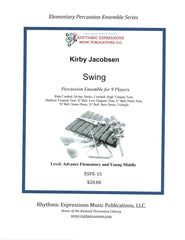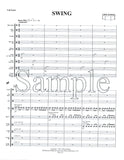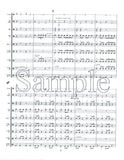Don't look now, but your school, church, or community band's holiday concert season is approaching fast! If you're looking for a complete set of percussion ensemble mu...
Shop by Category
Shop by Ensemble Size
Swing (Digital Copy)
$20.00
Performance Notes
SWING is a mid-tempo piece, featuring a classic swing beat. This piece is best suited for intermediate- to high school level ensembles. Rhythmically, SWING consists of ¼, ½ and whole rests, ¼ notes, 1/8th notes (groups of 2 and 4) and rests and 1/8th triplets. Brushes are seldom used in percussion ensembles; therefore, this is the perfect piece for their extended use.
The introduction is the familiar doorbell chime which is also featured in the intro to Miles Davis’ cover of “If I Were A Bell.” Letter A starts the building of a classic jazz drumset beat, divided amongst the ensemble. At letter B, the entrance of the “swishy” brush pattern on the snare drum, the hi-hat ‘chick’, then the sticks clicking at letter C, serve as very familiar and crucial elements of the beat pattern. The cowbell’s entrance at D adds to the feel. A low-pitched cowbell is necessary so as to not be sonically offensive to what is happening amongst the ensemble. The entrance of the ride cymbal at E serves to enhance the feel as well. The pattern remains steady so the swing feel can be emitted to the audience. The feel and the solo section are 2 essential elements of this piece. Letter F starts the solos section, which are inextricably tied to jazz music. All solos are written out for consistency and ease of playing. Letter I starts a ‘drum-heavy’, Gene Krupa-like drum pattern, followed by unison rhythms, then a 2-bar vocalization. Letter J is the outro, similar to letter A. The 2 ¼ notes played by the triangle in the last measure serve to assist the counting of the ½ rest before they end in a whispering of “yeah,” where they drop in pitch as they say the word—classic jazz vocals!
TIPS: Any solo section, F – I, may be repeated for open improvisation for more advanced students. The accompanying “Solo Ideas” sheet can be useful for open improvisation or mixed around and/or re-assigned amongst the players
Listen to Swing






